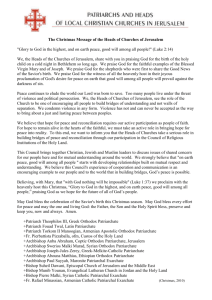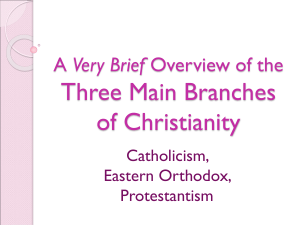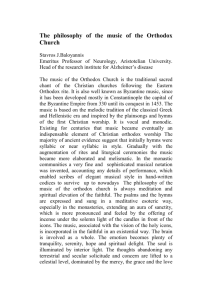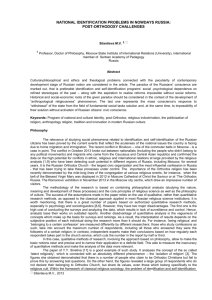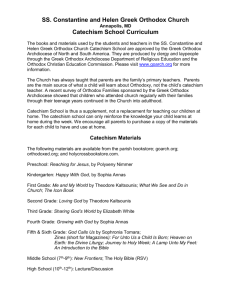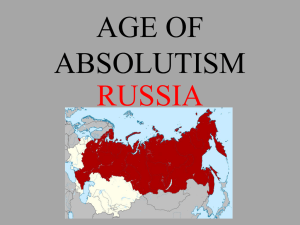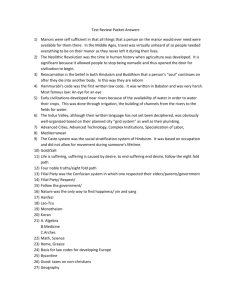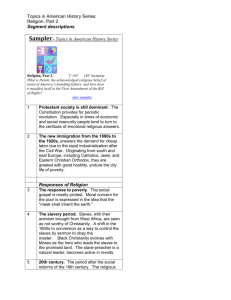The canonical Calvary of the Orthodox Church of France from the
advertisement
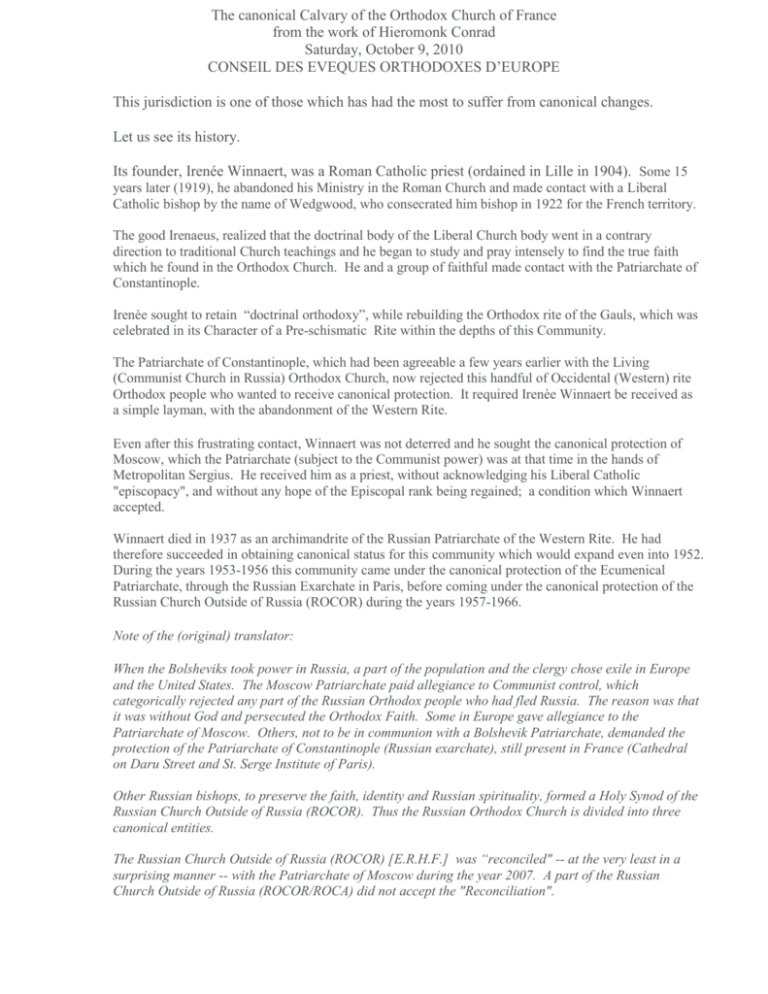
The canonical Calvary of the Orthodox Church of France from the work of Hieromonk Conrad Saturday, October 9, 2010 CONSEIL DES EVEQUES ORTHODOXES D’EUROPE This jurisdiction is one of those which has had the most to suffer from canonical changes. Let us see its history. Its founder, Irenée Winnaert, was a Roman Catholic priest (ordained in Lille in 1904). Some 15 years later (1919), he abandoned his Ministry in the Roman Church and made contact with a Liberal Catholic bishop by the name of Wedgwood, who consecrated him bishop in 1922 for the French territory. The good Irenaeus, realized that the doctrinal body of the Liberal Church body went in a contrary direction to traditional Church teachings and he began to study and pray intensely to find the true faith which he found in the Orthodox Church. He and a group of faithful made contact with the Patriarchate of Constantinople. Irenée sought to retain “doctrinal orthodoxy”, while rebuilding the Orthodox rite of the Gauls, which was celebrated in its Character of a Pre-schismatic Rite within the depths of this Community. The Patriarchate of Constantinople, which had been agreeable a few years earlier with the Living (Communist Church in Russia) Orthodox Church, now rejected this handful of Occidental (Western) rite Orthodox people who wanted to receive canonical protection. It required Irenée Winnaert be received as a simple layman, with the abandonment of the Western Rite. Even after this frustrating contact, Winnaert was not deterred and he sought the canonical protection of Moscow, which the Patriarchate (subject to the Communist power) was at that time in the hands of Metropolitan Sergius. He received him as a priest, without acknowledging his Liberal Catholic "episcopacy", and without any hope of the Episcopal rank being regained; a condition which Winnaert accepted. Winnaert died in 1937 as an archimandrite of the Russian Patriarchate of the Western Rite. He had therefore succeeded in obtaining canonical status for this community which would expand even into 1952. During the years 1953-1956 this community came under the canonical protection of the Ecumenical Patriarchate, through the Russian Exarchate in Paris, before coming under the canonical protection of the Russian Church Outside of Russia (ROCOR) during the years 1957-1966. Note of the (original) translator: When the Bolsheviks took power in Russia, a part of the population and the clergy chose exile in Europe and the United States. The Moscow Patriarchate paid allegiance to Communist control, which categorically rejected any part of the Russian Orthodox people who had fled Russia. The reason was that it was without God and persecuted the Orthodox Faith. Some in Europe gave allegiance to the Patriarchate of Moscow. Others, not to be in communion with a Bolshevik Patriarchate, demanded the protection of the Patriarchate of Constantinople (Russian exarchate), still present in France (Cathedral on Daru Street and St. Serge Institute of Paris). Other Russian bishops, to preserve the faith, identity and Russian spirituality, formed a Holy Synod of the Russian Church Outside of Russia (ROCOR). Thus the Russian Orthodox Church is divided into three canonical entities. The Russian Church Outside of Russia (ROCOR) [E.R.H.F.] was “reconciled" -- at the very least in a surprising manner -- with the Patriarchate of Moscow during the year 2007. A part of the Russian Church Outside of Russia (ROCOR/ROCA) did not accept the "Reconciliation". And so it is that this community which had received Canonical Protection on the part of several Patriarchates, received, in 1957, the Canonical Protection of a Church of “undoubted Canonicity but not recognized". "It is within this jurisdiction that the Orthodox Church of France became an autonomous Church through the Episcopal consecration (in 1964) of Vladika Kovalevsky. This ceremony was presided over by Bishop John Maximovich (better known under the name of St. John (Maximovich) of Shanghai and San Francisco and the Romanian Bishop of Paris, Teofilo Ionescu, and was allowed to retain its Western Rite Character. Vladika Kovalevsky, died in 1970, without a successor having been consecrated (...) On April 30, 1972 the French delegation concelebrated the Divine Liturgy with the Patriarch Justin, in full communion between the two churches. Finally on June 11, 1972, th of that same year, His Grace Bishop GERMAIN, who still heads the church, was consecrated bishop by three hierarchs of the Romanian Orthodox Church: Metropolitan Nicholas of Banat, Bishop Antoine Ploesteanu (vicar bishop of the Patriarch), and Archbishop Teofil/Theophilus of Sevres. The Decree of Enthronement of Bishop Hardy as Bishop of the Orthodox Church of France was dated of June 11, 1972. It is naturally signed by the Patriarch of Romania, because the new Church remained under its jurisdiction. The Synod of the Romanian Patriarchate renewed Western Orthodoxy when it established the Orthodox Catholic Church of France [L'Eglise Catholique Orthodoxe de France - L'ECOF] as an autonomous church by a synodal resolution on April 28, 1972. (Although no longer under the jurisdiction of the Romanian Patriarchate, the Orthodox Church of France remains devoted to continuing the mission for which it was established and received the blessing of Patriarch Justin.) In this way the France Orthodox Church, could have its own hierarchy and a canonical status. However with Patriarch Teoctist, things changed, and after almost 25 years of canonical existence within the Patriarchate of Romania, communion was finally broken. In 1993, yielding to the multiple pressures of the Churches of the emigration in France and the Patriarchate of Constantinople, the Church of Romania withdrew its canonical blessing and protection. The Orthodox Church of France has remained, since half way through the 1990’s, in a difficult canonical situation. Indeed, when a Bishop is alone, the consecration of new Bishops becomes impossible, in fact causing the impossibility of establishing a Synod which governs the Church. Despite this situation, the Orthodox Church of France is a jurisdiction of “undoubted Canonicity but not recognized". Currently, due to problems related with Bishop Germain, and before the real possibility of being deprived of a hierarchy (a situation that has already been experienced after the death of Vladika Kovalesky), many priests and French Orthodox faithful are working to establish “Canonical Protection” in connection with the Serbian Patriarchate; while others are watching with sympathy the Kiev Patriarchate. It should be emphasized, however, that both the Patriarchate of Serbia, and that of Kiev, fully recognize the validity and the sacramental grace of the clergy of the Orthodox Church of France. For this reason, the proposal of re-consecration of the clergy and the Chrismation of the faithful was in fact rejected. The Orthodox Church of France, beyond what his critics say, has the enormous virtue of having remained faithful to the Orthodox Faith, and of having survived such situations and difficult tests. Her fate will be found in the support of the rest of Orthodoxy (…). The doctrinal canonicity of the Church cannot be denied by anyone, despite any personal defects of Bishop Germain. Indeed, this Jurisdiction has been, from its origins, recognized by the Moscow Patriarchate, the Ecumenical Patriarchate (the Russian Exarchate from across Western Europe), by the Russian Orthodox Church Abroad/Outside of Russia [l'Église Orthodoxe Russe Hors Frontière] and by the Patriarchate de Romania. In early 2004, two parish communities of this jurisdiction in America (one of which is in Buenos Aires) abandoned the Orthodox Church of France to be eventually received under the Canonical Protection of Vladika Jeremias of the Ukrainian Orthodox Church of the United States and the Diaspora. These two Western Rite Orthodox communities have received special permission to keep the ancient Gallican Liturgy.
